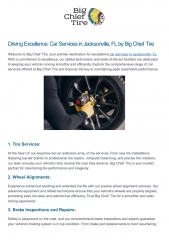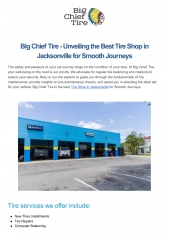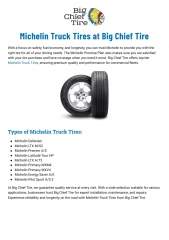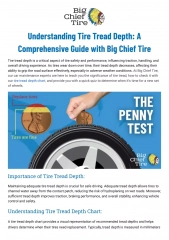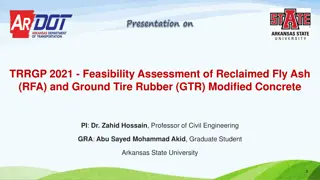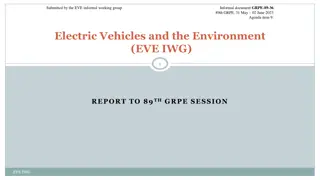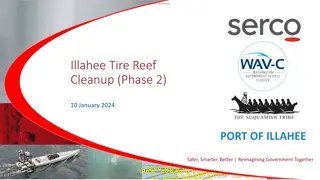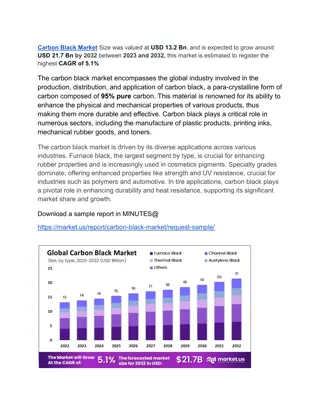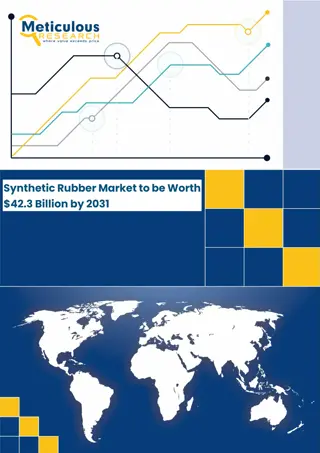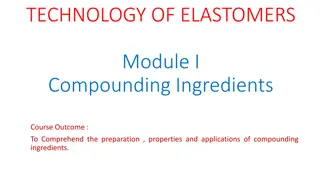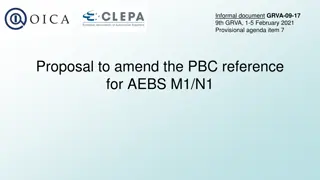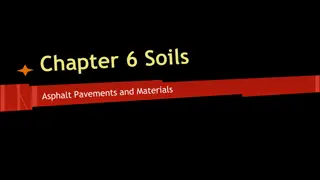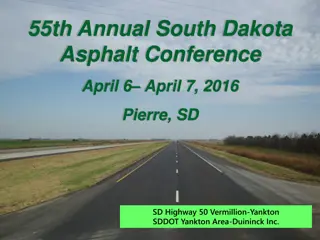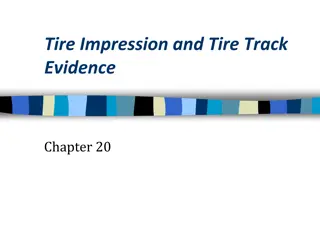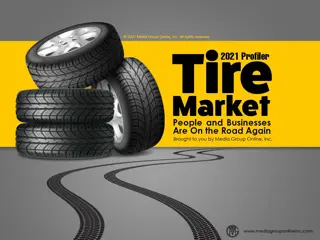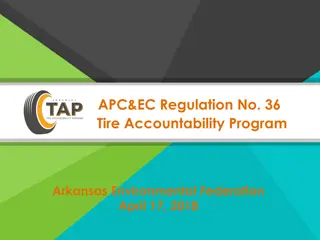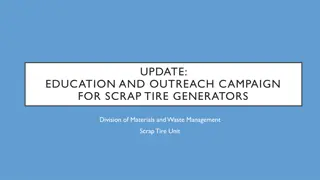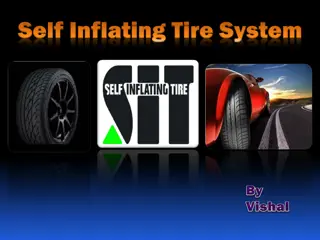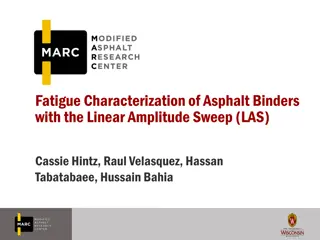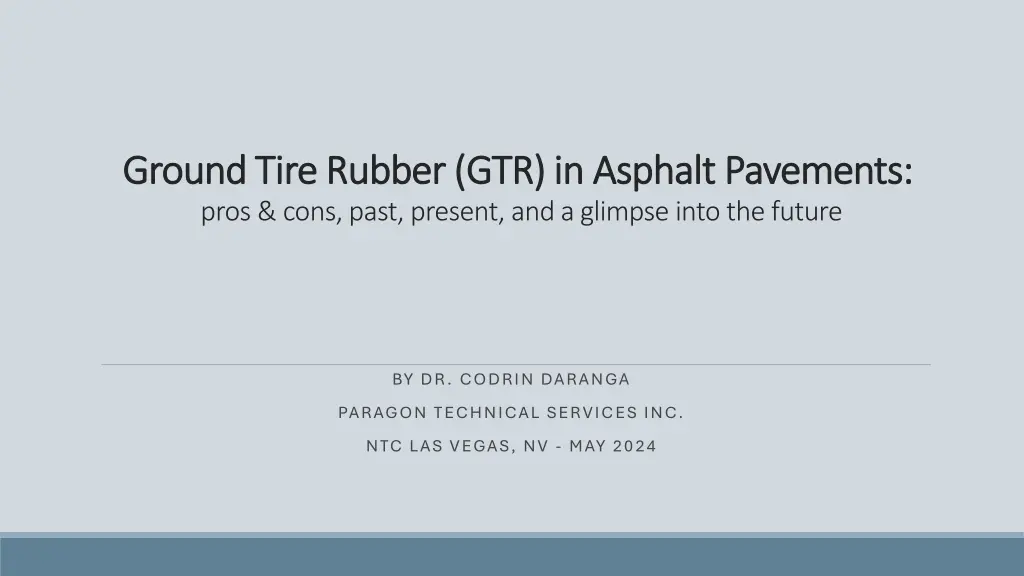
Ground Tire Rubber (GTR) in Asphalt Pavements: Past, Present, and Future Overview
Explore the utilization of Ground Tire Rubber (GTR) in asphalt pavements through a comprehensive overview covering the history, current status, and future prospects of this innovative recycling method. Delve into the engineering, economic, and environmental benefits along with practical considerations and a summary of the GTR application in asphalt pavements.
Download Presentation

Please find below an Image/Link to download the presentation.
The content on the website is provided AS IS for your information and personal use only. It may not be sold, licensed, or shared on other websites without obtaining consent from the author. If you encounter any issues during the download, it is possible that the publisher has removed the file from their server.
You are allowed to download the files provided on this website for personal or commercial use, subject to the condition that they are used lawfully. All files are the property of their respective owners.
The content on the website is provided AS IS for your information and personal use only. It may not be sold, licensed, or shared on other websites without obtaining consent from the author.
E N D
Presentation Transcript
Ground Tire Rubber (GTR) in Asphalt Ground Tire Rubber (GTR) in Asphalt P Pavements: pros & cons, past, present, and a glimpse into the future avements: BY DR. CODRIN DARANGA PARAGON TECHNICAL SERVICES INC. NTC LAS VEGAS, NV - MAY 2024
Presentation Overview Introduction Background How do we use GTR in asphalt Past Present Future? Practical considerations Summary
Presentation Overview Introduction Background How do we use GTR in asphalt Past Present Future? Practical considerations Summary
Introduction Introduction Recycling: Process of converting waste materials into now materials or objects. Alternative to conventional waste disposal, saves material and reduces environmental impact. Recycling of rubber from waste tires into asphalt pavements is an attractive alternative addressing engineering, economic, and environmental issues. ENGINEERING Triune Benefits of Recycling and Reuse 4
Introduction Introduction The Federal Highway Administration (FHWA) Recycled Materials Policy: Established in 2006. Recycling and Reuse offers triune benefits of engineering, economic, and environmental impact. economic needs, collectively referred to as the Triple Bottom Line. In-service asphalt pavement performance affects every facet of the FHWA recycled materials policy. Federal Highway Administration (FHWA) project: Deployment and Development of Innovative Asphalt Pavement Technologies. (DDIAPT) Resource Responsible (RR) use of Materials for Flexible Pavement Technical Report Resource Responsible Use of Recycled Tire Rubber in Asphalt Pavements https://scholarworks.unr.edu/handle/11714/7484 Comparatively, (ASCE), sustainability is made up of environmental, social, and 5
Presentation Overview Introduction Background How do we use GTR in asphalt Past Present Future? Practical considerations Summary
7 Typical Tire Typical Tire Components Components Component Natural rubber (NR) Synthetic rubber Carbon black Steel, fabric Processing oils and additives Typical Range 14 to 27 percent 14 to 27 percent 28 percent 14 to 15 percent 16 to 17 percent Production of pneumatic tires for passenger cars, trucks, airplanes, etc. uses large quantities of polymers: Natural Rubber (NR), Synthetic Styrene Butadiene Rubber (SBR), Ethylene Propylene Diene Monomer (EPDM) Rubber, Butyl Rubber (BR) Source PTSi
Waste Tire Issue Waste Tire Issue At the end of serviceable life, discarded waste tires contain as much as 99% of the total rubber used in tire construction. Environmental concern as polymeric materials do not decompose easily. Two major challenges: Waste of valuable rubber, Environmental pollution due to disposal of waste tires. 8
Waste Tire Issue Waste Tire Issue 9 Market or Disposition Thousands of Tons Millions of Tires % of Total to Market Tire-Derived Fuel (TDF) Cement Kilns Pulp & Paper Industrial Boilers Ground Tire Rubber (GTR) Civil Engineering (CE) Exported Electric Arc Furnace Reclamation Projects Agricultural Baled Tires/market Punched/ Stamped Other Total to Market Generated % to Market/Utilized Landfill Disposal % Managed (Includes Markets, Baled, and Landfill) 1,736.3 805.9 503.1 427.3 1,013.3 316.0 109.8 39.2 44.0 105.9 49.2 30.7 26.1 61.8 19.3 6.7 2.4 2.7 0.4 0.9 1.4 6.6 208.1 255.6 81.4% 39.5 96.9% 50.9 23.6 14.8 12.5 29.7 9.3 9.3 3.2 1.2 1.3 0.2 0.4 0.7 100.0 7.1 14.6 22.5 108.5 3,411.3 4,189.2 81.4% 646.8 96.9% SourceUSTMA
Waste Tire Issue Waste Tire Issue In 2017 Scrap Tire Markets consumed 81.4 percent of the estimated 4.3 million tons of scrap tires generated annually. Civil Engineering 9.3% Waste Waste Tire Tire Issue Issue Tire-Derived Fuel 50.9% Ground Tire Rubber, 29.7% Source PTSi 10
Waste Tire Issue Waste Tire Issue The GTR market is reported at slightly more than 1.0 million tons or about 62 million scrap tires. Asphalt, 119 Sports Surfacing, 234 Automotive, 32 Playgrounds/Mulch, 243 Molded/Extruded Products, 386 Source PTSi 11
Presentation Overview Introduction Background How do we use GTR in asphalt Past Present Future? Practical considerations Summary
Historical Perspective Historical Perspective More than 50 years of success in GTR modification of asphalt binders. GTR modification of asphalt binders ranks second among polymer modifiers. Modern GTR asphalt modification began in the early 1960s, Asphalt Rubber (AR) modified chip seal Phoenix, AZ, AR expanded into greater chip seal usage, crack relief interlayers and open-graded friction courses (OGFC) During 1960s through 1970s AR proved useful in asphalt pavements and pavement maintenance. 13
Historical Perspective Historical Perspective During 1960s through 1970s dry mixture addition of GTR emerged. More issue with early dry mixture addition than dry addition today Rubber Modified Asphalt Concrete (RUMAC) 10 mesh at 3 percent by weight of mix. PlusRideTM TAKTM Dry addition of GTR to mixtures today consists of smaller sized rubber and lower rubber content 30 mesh at 0.5 percent by weight of mix (10 percent of binder based on 5.0 percent binder content) Dry addition technology today generally employs co-additives 14
Presentation Overview Introduction Background How do we use GTR in asphalt Past Present Future? Practical considerations Summary
16 Current Usage Current Usage State DOT published specifications revealed that only twelve States currently publish specifications allowing GTR-modified asphalt binders for use in construction of asphalt pavements.
Current Usage Current Usage State % of Total Tons of GTR Used 21.4 Tons of GTR Used Arizona 4,303 Arkansas 5 <0.1 California 13,412 66.7 Delaware 10 <0.1 Florida 136 0.7 Georgia 378 1.9 Illinois 750 3.7 Massachusetts 710 3.5 Michigan 55 0.3 Missouri 260 1.3 Texas 98 0.5 Total 20,117 100.0 17
18 Processes and Processes and Technologies Technologies Technology Process Product Material 1960 s - Arizona McDonald Process Currently there are two primary processes of incorporating GTR into asphalt binders and mixtures referred to as either the wet or dry process. 1989 - Florida GTR Modified Binder (Asphalt Rubber or Rubber Modified Binder) Continuous Blend Wet 1992 - Arizona Terminal Blend Ground Tire Rubber The wet process blends GTR with asphalt with one of two technologies: 1960 s - Sweden Plus Ride RUMAC, TAK Wet Process 1990 s - Kansas Generic Dry-Process GTR Modified Hot-Mix Asphalt Mixture Dry Terminal Blend 2010 s - Georgia The dry process incorporates GTR directly into the asphalt mixture during production Asphalt Plus SmartMix
Asphalt Rubber (AR) Asphalt Rubber (AR) Technologies Included in This Process Technology Definition Other Names of the Technology An asphalt binder in various types of flexible pavement construction including surface treatments and asphalt mixtures consisting of a blended asphalt binder, ground tire rubber (GTR), and certain additives in which the rubber component is at least 15 percent by weight of the total blend and has reacted in the asphalt binder sufficiently to cause swelling of the rubber particles. McDonald Process Arizona Crumb Rubber Wet Process Rubber Recycled Tire Rubber Modified Bitumen (RTR-MB) Asphalt Rubber Binder (ARB) Bitumen Rubber Binder Crumb Rubber Binder Batch Blending Asphalt Rubber (AR) 19
Rubber Modified Binder (RMB) Rubber Modified Binder (RMB) Technologies Included in This Process Other Names of the Technology Technology Definition A version of the wet process where ground tire rubber (GTR) is blended with asphalt binder at the refinery or at an asphalt binder storage and distribution terminal and transported to the asphalt mix plant or job site for use. These blends may contain from 5 to 12 percent GTR by total asphalt binder mass. Some hybrid RMB binders may contain polymers such as styrene-butadiene-styrene (SBS) in addition to GTR. Terminal Blend Terminal Blended Rubberized Asphalt (TBRA) Recycled Tire Rubber Modified Bitumen (RTR-MB) Rubber Modified Binder (RMB) Hybrid Rubber Binder Wright Process Rubber Modified Binder (RMB) 20
Dry Process Rubber Dry Process Rubber Technologies Included in This Process Technology Definition Other Names of the Technology A process where hot-mix asphalt mixture is modified with ground tire rubber (GTR) using GTR as an aggregate/binder modifier which is incorporated into the aggregate prior to mixing with asphalt binder producing a GTR-modified hot-mix asphalt mixture. GTR used in this technology is generally less than 0.6mm (30 mesh). Dry process rubber Belt add modifier (BAM) Dry Process 21
Presentation Overview Introduction Background How do we use GTR in asphalt Past Present Future? Practical considerations Summary
Future: What does it look like? Ideally, we will find a way to keep GTR from separating/settling in asphalt. Maybe figure out how to get more participation from the polymers in GTR. For RTR in general ideally would be to find a way back to the starting materials (no, de- vulcanization is not real, it is a stretching of the truth at best).
Presentation Overview Introduction Background How do we use GTR in asphalt Past Present Future? Practical considerations Summary
Specifications and Testing of GTR-Modified Asphalt Binders Wet Process The Superpave asphalt binder specification (AASHTO M 320 Standard Specification for Performance-Graded Asphalt Binder) encourages wider use of rheology-based testing of GTR-modified asphalt binders using the wet process and either the AR or RMB technology. The Multiple-Stress Creep and Recovery (MSCR) (AASHTO M 332 Standard Specification for Performance- Graded Asphalt Binder Using Multiple Stress Creep Recovery (MSCR) Test) testing may also be employed. 25
Specifications and Testing of GTR-Modified Asphalt Mixtures Dry Process Specification and certification of mixtures modified with GTR using the dry process is not as straightforward as when the wet process is used. Some agencies have specified the GTR-modified asphalt binder be evaluated and certified via asphalt binder extraction, recovery, and subsequent testing of recovered asphalt binder when the dry process is used. 26
Specifications and Testing of GTR-Modified Asphalt Mixtures Dry Process Extracted asphalt binder testing poses one of two, possibly both, concerns: Is GTR/GTR modified asphalt binder totally recovered from the mixture, does solvent interaction incorporate rubber and asphalt binder in a manner not achieved in the in-place mixture. Specification of the mixture using the dry process is possibly more appropriately based on mixture testing schemes such as the balanced mixture design (BMD) approach. 27
Practical considerations Make sure the GTR particles have room in the mix design/aggregate gradation. GTR even when in the binder it is NOT binder therefore it does not replace binder. For example: if using 10% by wt. GTR modified asphalt you really get more surface area to coat (aggregate plus GTR) with less binder (90% instead of 100%). Need to bump the AC content, usually by 0.2 to 0.5% AC in the mix. Ensure proper equipment is available to prevent settlement and maintain binder homogeneity.
Presentation Overview Introduction Background How do we use GTR in asphalt Past Present Future? Practical considerations Summary
Summary Lacking the ability to recycle old tires into new tires, there are several common repurposing methods to effectively reuse rubber. GTR is the second highest consumer of RTR with uses in: Molded and extruded products, Playground and mulch applications, Sports surfacing, Asphalt binder modification, Automotive uses. Modification of asphalt binders with GTR is well established and can provide high performance pavements that aid in reduction of the number of waste tires disposed of in landfills and elsewhere. Growth in use of GTR-modified asphalt pavements can be credited to successful construction of high- performance asphalt pavements
Summary GTR is being successfully used in Pavements in both wet and dry form. Proper design needed to insure adequate performance If specification do not allow it, it is not happening! History of both good and bad performance can be found out in the real world going back for many years. NCAT, MnRoad and many more examples available in the real world of successful GTR containing pavements.


